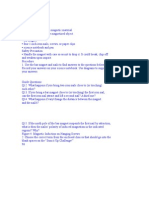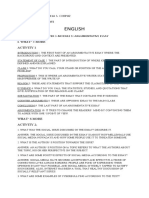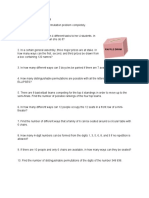Activity 8: Activity 7: Give Me More Companions Answer Key
Activity 8: Activity 7: Give Me More Companions Answer Key
Uploaded by
Nico Paolo L. BaltazarCopyright:
Available Formats
Activity 8: Activity 7: Give Me More Companions Answer Key
Activity 8: Activity 7: Give Me More Companions Answer Key
Uploaded by
Nico Paolo L. BaltazarOriginal Description:
Original Title
Copyright
Available Formats
Share this document
Did you find this document useful?
Is this content inappropriate?
Copyright:
Available Formats
Activity 8: Activity 7: Give Me More Companions Answer Key
Activity 8: Activity 7: Give Me More Companions Answer Key
Uploaded by
Nico Paolo L. BaltazarCopyright:
Available Formats
Activity 8
2. y = -x³ + 2x² + 11x -12 or y = -(x+3)(x-1)(x-4)
(a) -3, 1, 4
(b) x < -3, -3 < x < 1, 1< x < 4, x > 4(c) Intervals
x < -3 -3 < x < 1 1< x < 4 x>4
Test Value -4 0 2 5
2x + 3 - + + +
x-1 - - + +
x-4 - - - +
y=-(x+3)(x-1)(x-4) + - + -
Position of the above below above below
curve relative to
the x-axis
3. y = x⁴-26x²+ 25 or y = (x+5)(x+1)(x-1)(x-5)
(a) -5, -1, 1, 5
(b) x < -5, -5 < x < -1, -1< x < 1, 1< x < 5, x > 5
Intervals
x < -5 -5 < x < -1 -1< x < 1 1< x < 5 x>5
Test Value -6 -2 0 2 6
x+5 - + + + +
x+1 - - + + +
x-1 - - - + +
x-5 - - - - +
y = x⁴-26x²+ 25 + - + - +
Position of the above below above below above
curve relative
to the x-axis
Answers to the Questions:
1. For y=(2x+3)(x-1)(x-4)
a. Since there is no other x-intercept to the left of −32 , then the graph falls to the left continuously without end.
b. (i) −32 < x < 1 and x > 4(ii) x <−32 and 1 <x <4
c. Since there is no other x-intercept to the right of 4, then the graph rises to the right continuously without end.
d. leading term: 2x³
e. leading coefficient: 2, degree: 3
2. For y= -x³ + 2x² + 11x -12 or y= -(x+3)(x-1)(x-4)
a. Since there is no other x-intercept to the left of -3, then the graph rises to the left continuously without end.
b. (i) x <-3 and 1 <x <4(ii) -3 <x <1 and x > 4
c. Since there is no other x-intercept to the right of 4, then the graph falls to the right continuously without end.
d. leading term: -x³
e. leading coefficient: -1, degree: 3
3. For y= x⁴-26x²+ 25 or y= (x+5)(x+1)(x-1)(x-5)
a. Since there is no other x-intercept to the left of -3, then the graph rises to the left continuously without end.
b. (i) x <-5 and -1 <x <1(ii) -5 <x <1 and 1 <x <5
c. Since there is no other x-intercept to the right of 5, then the graph falls to the right continuously without end.
d. leading term: x⁴
e. leading coefficient: 1, degree: 4
Activity 5 Find my Match Activity 6 Seize and Intercept Me
1. B6. F1. x-intercepts: 0, -4, 3. x-intercepts: 2, -2
2. E7. G2. x-intercepts: 2, 1, -35. x-intercepts: 0, 1, -1, -3, 3
3. D8. J3. x-intercepts: 1, -1, 3
4. C9. I
5. A10. H
Activity 7 : Give Me More Companions
Answer Key
1. x-intercepts: -4, -2, 1, 3
y- -5 -3 0 2 4
interce
pt: 24x
y 144 -24 24 -24 -144
Activity 1: Which is which?
1. Polynomial
2. Not polynomial because the variable of one term is inside the radical sign
3. Polynomial
4. Not polynomial because the exponent of the variable are not whole numbers
5. not polynomial because the variables are in the denominator
6. polynomial
7. not polynomial because the exponent of one variable is not a whole number
8. polynomial
9. not polynomial because the exponent of one variable is negative
10. polynomial
Activity 2: Fix Polynomial Degree Leading Coefficient Constant Term
and Move them, Function in
then Fill me Standard Form
upPolynomial
Function
1. f(x) = 2 –11x + f(x) = 2x²-11x + 2 2 2 2
2x²
2. f(x) = 2𝑥³3 + 53 + f(x) = 2𝑥³3 + 15x + 53 3 23 53
15x
3. y = x (x²-5) y = x³-5x 3 1 0
4. y = x (x+3) (x-3) y = x³+ 9x 3 -1 0
5. y = (x+4) (x+1) y = x⁴+ 3x³ -5x² -3x + 4 1 4
(x-1)² 4
Activity 3 Term with Term/s with lower Constant Standard
Complete highest exponents in term form
MeComplete the exponent descending order
table
below.Polynomial
Function
1. 𝑓(𝑥) = 4 + 4𝑥4+ 4𝑥4 8𝑥 4 𝑓(𝑥) = 4𝑥4+ 8𝑥 +
8𝑥 4
2. 𝑓(𝑥) = (𝑥 + 2) 𝑥2 0 -4 𝑓(𝑥) = 𝑥2− 4
(𝑥 − 2)
3. 𝑦 = 1 + 2𝑥 + 𝑥3 x3 2x 1 𝑦 = 𝑥3+ 2x + 1
4. 𝑦 = −5 + 5𝑥10+ 5𝑥10 5𝑥5 −5 𝑦 = 5𝑥10+ 5𝑥5− 5
5𝑥5
5. 𝑓(𝑥) = 𝑥2− 9𝑥5+ −9𝑥5 𝑥2 6 𝑓(𝑥) = − 9𝑥5+ x2
6 +6
Activity 4 Substitute and Know Me
Write the factored form of the following polynomial functions by completing the table:1. 𝑦 = 343𝑥3+ 27
Find 𝑎 and 𝑏 𝑎 = 7𝑥
(𝑎 is the cube root of the first term) 𝑏=3
(𝑏 is the cube root of the second term)
Substitute the values of 𝑎 and 𝑏 in 𝑦 = (7𝑥 + 3)[(7𝑥)2− 2(7𝑥)(3) + (3)2]
(𝑎 + 𝑏)(𝑎2− 𝑎𝑏 + 𝑏2)
So, the factored form is 𝒚 = (𝟕𝒙 + 𝟑)(𝟒𝟗𝒙 2− 𝟐𝟏𝒙 + 𝟗)
2. 𝑦 = 27𝑥3− 8
Find 𝑎 and 𝑏 𝑎 = 3𝑥
(𝑎 is the cube root of the first term) 𝑏=2
(𝑏 is the cube root of the second term)
Substitute the values of 𝑎 and 𝑏 in 𝑦 = (3𝑥 − 2)[(3𝑥)2+ (3𝑥)(2) + (2)2]
(𝑎 − 𝑏)(𝑎2+ 𝑎𝑏 + 𝑏2)
So, the factored form is 𝒚 = (𝟑𝒙 − 𝟐)(𝟗𝒙2+ 𝟔𝒙 + 𝟒)
3. 𝑦 = 𝑥3+ 3𝑥2− 4𝑥 − 12
Group the terms (𝑎𝑥3+ 𝑏𝑥2) + (𝑐𝑥 + 𝑑) y =( x3+ 3x2) + (-4x -12)
Factor 𝑥2 out of the first group of terms. y = x2(x + 3) + ( -4x -12)
Factor the constants out of both groups. y = x2(x + 3) -4 (x + 3)
Add the two terms by adding the coefficients y = (x2–4)(x + 3)
This can be further factored as a difference y = (x + 2)(x –2)(x + 3)
of squares
So, the factored form is y = (x + 2)(x –2)(x + 3)
4. 𝑦 = 𝑥4− 5𝑥2+ 4
Treat 𝑎4as (𝑎2)2 𝑦 = (x2)2–5(x2) + 4
(𝑥2)2−𝑏(𝑥2) + 𝑐
Let 𝑥2 = 𝑥 , thus, it shows a quadratic 𝑦 = 𝑥2–5x + 4
trinomial: 𝑎𝑥2+ 𝑏𝑥 + 𝑐 𝑦 = (𝑥 − 4)(𝑥 − 1)
Factor it:
Put it back. (Substitute 𝑥 = 𝑥2) 𝑦 = (𝑥2− 4)(𝑥2 −1)
This can be further factored as a difference y = (x + 2)(x –2)(x + 1)(x –1)
of Two squares
So, the factored form is y = (x + 2)(x –2)(x + 1)(x –1)
You might also like
- Vmware Vsphere: Install, Configure, Manage: Lab Manual Esxi 7 and Vcenter Server 7Document127 pagesVmware Vsphere: Install, Configure, Manage: Lab Manual Esxi 7 and Vcenter Server 7cerro Granada100% (3)
- CompTIA A+ Guide To IT Technical Support Chapter 2 Lecture SlidesDocument75 pagesCompTIA A+ Guide To IT Technical Support Chapter 2 Lecture SlidesWaaiez100% (2)
- Six Sigma Versus Lean Manufacturing - An OverviewDocument7 pagesSix Sigma Versus Lean Manufacturing - An OverviewNuriaNo ratings yet
- AutoForm OneStepDocument96 pagesAutoForm OneSteptuấnNo ratings yet
- Week 1 Learning Task 1: Evaluate The Following Polynomials in Your Answer SheetDocument12 pagesWeek 1 Learning Task 1: Evaluate The Following Polynomials in Your Answer SheetlouiseNo ratings yet
- g-10 Activity Unit2Document10 pagesg-10 Activity Unit2marjja millanNo ratings yet
- MATH 10 Find The Sum of The Following Arithmetic SequenceDocument7 pagesMATH 10 Find The Sum of The Following Arithmetic SequenceJannea Pearl PongcolNo ratings yet
- MATH 10 3rd QuarterDocument16 pagesMATH 10 3rd QuarterLourdes de JesusNo ratings yet
- Walk With The NatureDocument6 pagesWalk With The NatureRenegen Aganon100% (1)
- 3rd Quarter Lessons in MapehDocument25 pages3rd Quarter Lessons in MapehCarodan Mark JosephNo ratings yet
- Permutations Combination2Document41 pagesPermutations Combination2Li Ga YaNo ratings yet
- 10) Cje1 .-9c!c'lDocument36 pages10) Cje1 .-9c!c'lKISS MY ASSNo ratings yet
- Forms of Multimedia in The PhilippinesDocument4 pagesForms of Multimedia in The Philippinesivi pearl dagohoyNo ratings yet
- Exposition EditedDocument6 pagesExposition EditedMika Alarcon Mendoza100% (1)
- Gorgon OutlineDocument4 pagesGorgon OutlineDanger Zac 9No ratings yet
- Extended DefinitionDocument13 pagesExtended DefinitionAhcel Ortiz SomodioNo ratings yet
- Amorin Family's Month Expenses: Circle This Problem Gives You The Chance ToDocument4 pagesAmorin Family's Month Expenses: Circle This Problem Gives You The Chance ToJon VaderNo ratings yet
- 5 Words Related To Building Ties and The TitleDocument1 page5 Words Related To Building Ties and The TitleGeorich NarcisoNo ratings yet
- Taas, YV II MSPowerPoint - OutputDocument16 pagesTaas, YV II MSPowerPoint - OutputYVETTE TAAS100% (1)
- Quarter Ii - Periodical Examination (1-60)Document4 pagesQuarter Ii - Periodical Examination (1-60)ELIAS DE MESANo ratings yet
- Q4 Music 10 Week5 PDFDocument5 pagesQ4 Music 10 Week5 PDFJoy Dela Peña JimenezNo ratings yet
- English10 q3 Mod5 Examiningtexts v2Document47 pagesEnglish10 q3 Mod5 Examiningtexts v2Faith MontefalcoNo ratings yet
- Health 10 1st GradingDocument2 pagesHealth 10 1st GradingLiezl VillanuevaNo ratings yet
- LP IjDocument8 pagesLP IjJudy Mae Jose Antopina100% (1)
- Tangent Line: U Is A Point On The Circle, Then One and Only OneDocument5 pagesTangent Line: U Is A Point On The Circle, Then One and Only OneCristina AlbertoNo ratings yet
- The Teacher Will Stress The Ff. Points:: Concept NotesDocument2 pagesThe Teacher Will Stress The Ff. Points:: Concept NotesAnonymous KF6aPhNo ratings yet
- Earth's InteriorDocument3 pagesEarth's InteriorJerwin Fernandez Torralba100% (2)
- Jose Montserrat Maceda: Filipino National ArtistDocument11 pagesJose Montserrat Maceda: Filipino National ArtistShaneMekhaela FarnalNo ratings yet
- Quarter 1 - Module 2 Modern Art: (Abstract Expressionism, Pop Art, Op Art, Installation Art and Performance Art)Document12 pagesQuarter 1 - Module 2 Modern Art: (Abstract Expressionism, Pop Art, Op Art, Installation Art and Performance Art)Juan Paulo GacillaNo ratings yet
- I. Learning ObjectiveDocument7 pagesI. Learning Objectivenorhanifah matanogNo ratings yet
- Learning Task 6 Cybercrime Complaints in The PhilippinesDocument3 pagesLearning Task 6 Cybercrime Complaints in The PhilippinesJeof Reborn100% (1)
- Scan 20150805Document1 pageScan 20150805Jrom Ecleo100% (2)
- MAPEH 10 Music Q2 1Document33 pagesMAPEH 10 Music Q2 1jixNo ratings yet
- Arts Module q3Document11 pagesArts Module q3Rick RhomanNo ratings yet
- PortfolioDocument6 pagesPortfolioCarlEspantoNo ratings yet
- Presentation - Laurence ErandioDocument17 pagesPresentation - Laurence ErandioRonnel Andres HernandezNo ratings yet
- Math10Q2M2 Activity SheetsDocument10 pagesMath10Q2M2 Activity SheetsLavinia RamosNo ratings yet
- Quarter 2 - Module 4 - Abella-Trisha-Mae-DDocument15 pagesQuarter 2 - Module 4 - Abella-Trisha-Mae-DAnonpc100% (1)
- Soal PISA 2012 PDFDocument76 pagesSoal PISA 2012 PDFsadamNo ratings yet
- Test Item Bank - English10Document131 pagesTest Item Bank - English10ma. glenda p. sabulaoNo ratings yet
- KeeshquestionsDocument13 pagesKeeshquestionst3xxaNo ratings yet
- Science10 - Q4 - Week 5 Chemical Reactions PDFDocument6 pagesScience10 - Q4 - Week 5 Chemical Reactions PDFadrianneNo ratings yet
- 3rd Periodic Test-Grade 10Document6 pages3rd Periodic Test-Grade 10Ailene CeriloNo ratings yet
- G10 Q1 L2 Seismic Waves EpicenterDocument26 pagesG10 Q1 L2 Seismic Waves EpicenterRoan BodinoNo ratings yet
- Tle-Css Q3Document31 pagesTle-Css Q3jeromeNo ratings yet
- Alabel National Science High SchoolDocument2 pagesAlabel National Science High SchoolWilkenn TuazonNo ratings yet
- Math ProjectDocument4 pagesMath ProjectEdgar Pigao SoteloNo ratings yet
- Music 10 - Q4 - M1W12 CO 1Document39 pagesMusic 10 - Q4 - M1W12 CO 1creguerro.13No ratings yet
- English Q3-Module 1Document3 pagesEnglish Q3-Module 1Frances CorpuzNo ratings yet
- Philippine Media-Based Arts: PhotographyDocument29 pagesPhilippine Media-Based Arts: PhotographyShaun ObutaNo ratings yet
- Quiz4 Q3Document4 pagesQuiz4 Q3Reginald MundoNo ratings yet
- Imageformationinlens 110819210040 Phpapp01Document37 pagesImageformationinlens 110819210040 Phpapp01Jasmine Sebastian100% (1)
- Activity 6: RAFFLE DRAW Direction: Answer Each Permutation Problem CompletelyDocument1 pageActivity 6: RAFFLE DRAW Direction: Answer Each Permutation Problem CompletelyPaopao MacalaladNo ratings yet
- Week 1 ARTS g10Document7 pagesWeek 1 ARTS g10Israel MarquezNo ratings yet
- English 10Document17 pagesEnglish 10Dorothy Joyce DXNo ratings yet
- English: Quarter 1 - Module 3 What Lies BehindDocument14 pagesEnglish: Quarter 1 - Module 3 What Lies Behindjohn erick camota100% (3)
- Q4 LAS Arts 10-WK-5-8Document16 pagesQ4 LAS Arts 10-WK-5-8Liam AlexanderNo ratings yet
- Pointers in MAPEH 10Document3 pagesPointers in MAPEH 10Sean CampbellNo ratings yet
- Arts10 Q2-2bDocument12 pagesArts10 Q2-2bAnita MusniNo ratings yet
- English 2nd Quarter Module 3Document136 pagesEnglish 2nd Quarter Module 3Maria Odessa100% (1)
- Mapeh 10Document26 pagesMapeh 10Arriane Kaye Ani0% (1)
- MCR3UC - Functions: Grade 11, University Preparation, 1.0 Credit Unit 1: Characteristics of Functions Key Questions - (5x) 1 + 3 (4x) + 1 (6) XDocument10 pagesMCR3UC - Functions: Grade 11, University Preparation, 1.0 Credit Unit 1: Characteristics of Functions Key Questions - (5x) 1 + 3 (4x) + 1 (6) XKhara BurrsNo ratings yet
- Stguidefinal SolutionsDocument49 pagesStguidefinal SolutionssarmadNo ratings yet
- GenMath11 Q2 Mod-6Document20 pagesGenMath11 Q2 Mod-6Nico Paolo L. BaltazarNo ratings yet
- GRADE 10 Q1 SUMMATIVEASSESSMENTand PERFORMANCE TASKDocument10 pagesGRADE 10 Q1 SUMMATIVEASSESSMENTand PERFORMANCE TASKNico Paolo L. BaltazarNo ratings yet
- OrganizationAndManagement Activity Week 4 NicoPaoloLBaltazar Grade 11 Bloomberg AnswersDocument6 pagesOrganizationAndManagement Activity Week 4 NicoPaoloLBaltazar Grade 11 Bloomberg AnswersNico Paolo L. BaltazarNo ratings yet
- Weekly Learning Activity Sheet: Assess Quality of Received Materials/Components and Input Data Into The ComputerDocument9 pagesWeekly Learning Activity Sheet: Assess Quality of Received Materials/Components and Input Data Into The ComputerNico Paolo L. BaltazarNo ratings yet
- 21st Century Activity Module 3 NicoPaoloLBaltazar Grade 11 Bloomberg AnswersDocument6 pages21st Century Activity Module 3 NicoPaoloLBaltazar Grade 11 Bloomberg AnswersNico Paolo L. BaltazarNo ratings yet
- 21 Century From The Philippines and The World Quarter 1 - Module 1: Geographic, Linguistic and Ethnic Dimensions of Philippine LiteraryDocument6 pages21 Century From The Philippines and The World Quarter 1 - Module 1: Geographic, Linguistic and Ethnic Dimensions of Philippine LiteraryNico Paolo L. BaltazarNo ratings yet
- ETECH Grade11 Bloomberg Nico Paolo L Baltazar AnswersDocument4 pagesETECH Grade11 Bloomberg Nico Paolo L Baltazar AnswersNico Paolo L. BaltazarNo ratings yet
- NicoPaoloL BaltazarEnglishSummativeTest1Document2 pagesNicoPaoloL BaltazarEnglishSummativeTest1Nico Paolo L. BaltazarNo ratings yet
- 2 Online Safety Security Ethics and EtiquetteDocument66 pages2 Online Safety Security Ethics and EtiquetteNico Paolo L. BaltazarNo ratings yet
- Q2 - First Summative Test: Mathematics 10 SY: 2020 - 2021Document3 pagesQ2 - First Summative Test: Mathematics 10 SY: 2020 - 2021Nico Paolo L. BaltazarNo ratings yet
- Faculty Call Letter RSETI Exam TripuraDocument306 pagesFaculty Call Letter RSETI Exam TripuraAshish Kumar SinghNo ratings yet
- Flow Control Applications: NASA/TM-2020-220436Document33 pagesFlow Control Applications: NASA/TM-2020-220436JINU CHANDRANNo ratings yet
- DAIKIN EVO Inverter 2023Document2 pagesDAIKIN EVO Inverter 2023Fadhlan Agung AbdillahNo ratings yet
- Module 5 Power TrainsDocument33 pagesModule 5 Power TrainsBilly JhunNo ratings yet
- Contact Thermometers: With Remote IndicationDocument1 pageContact Thermometers: With Remote IndicationJOSE DANIEL PEREZNo ratings yet
- Overview of Windows Admin CenterDocument3 pagesOverview of Windows Admin CenterrolekNo ratings yet
- PO BOX:41027, Dammam-31521 Kingdom of Saudi Arabia. Petronash Arabia Co. LTDDocument18 pagesPO BOX:41027, Dammam-31521 Kingdom of Saudi Arabia. Petronash Arabia Co. LTDUmair RazaNo ratings yet
- Youtube Optimization ProposalDocument3 pagesYoutube Optimization ProposalMichelle CastilloNo ratings yet
- Exercises and WorkshopsDocument53 pagesExercises and WorkshopsShaikh Yaseen MehmoodNo ratings yet
- Datasheet-Deye 8kw 220vDocument1 pageDatasheet-Deye 8kw 220vHelison MedinaNo ratings yet
- A Seminar Report On Management of SupplyDocument25 pagesA Seminar Report On Management of SupplyRijana ShresthaNo ratings yet
- TECHNICAL SPECIFICATION-bladeless Fun With Heater Table Model (Ventilador Con Base)Document5 pagesTECHNICAL SPECIFICATION-bladeless Fun With Heater Table Model (Ventilador Con Base)Samantha Tomayquispe MejíaNo ratings yet
- SmartSolar MPPT RS-enDocument51 pagesSmartSolar MPPT RS-enwongdongNo ratings yet
- 21CSL66 Lab ManualDocument60 pages21CSL66 Lab ManualdeepakchabriNo ratings yet
- QSK23G3Document3 pagesQSK23G3mohsen_cumminsNo ratings yet
- Tower 6Document885 pagesTower 6Drazen SamardzicNo ratings yet
- Engineering Design Outsourcing - Pharmaceutical PlantDocument1 pageEngineering Design Outsourcing - Pharmaceutical PlantchemionixNo ratings yet
- Business Analysis Essential DocumentsDocument8 pagesBusiness Analysis Essential Documentsramirez1133No ratings yet
- JOM2014 Soderberg Tech North South America ATTMBDocument13 pagesJOM2014 Soderberg Tech North South America ATTMBgefregmail.comNo ratings yet
- Annex XIII - UNFPA Client Communication Request ApplicationDocument36 pagesAnnex XIII - UNFPA Client Communication Request ApplicationIsmail AdebiyiNo ratings yet
- Nutanix Certified Expert - Multicloud Infrastructure (NCX-MCI)Document15 pagesNutanix Certified Expert - Multicloud Infrastructure (NCX-MCI)TizoconNo ratings yet
- Knowledge Representation TechniquesDocument74 pagesKnowledge Representation TechniquesDhanraj KumarNo ratings yet
- Major Project 47-PublicationDocument60 pagesMajor Project 47-PublicationSAURAJ PANDEYNo ratings yet
- Viewz - Vz-55unbsDocument2 pagesViewz - Vz-55unbsjosev_3000No ratings yet
- Statement ELDocument20 pagesStatement ELKris TheVillainNo ratings yet
- Bangladesh National ICT Policy 2009: Key Features and ChallengesDocument20 pagesBangladesh National ICT Policy 2009: Key Features and ChallengesArab AhmedNo ratings yet



































































































